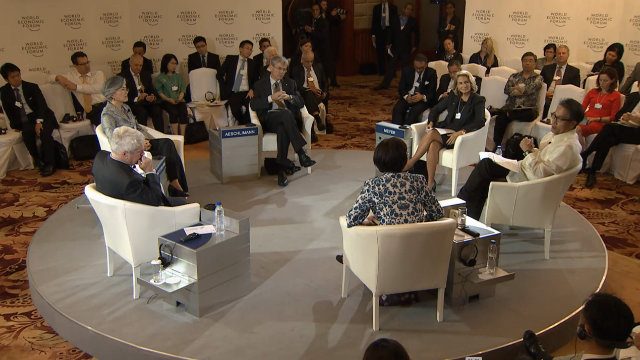SUMMARY
This is AI generated summarization, which may have errors. For context, always refer to the full article.

MANILA, Philippines – While there is no shortage of unprecedented man-made and natural disruptions in East Asia, most countries are still unprepared to mitigate the impact of these disruptions.
This is according to industry experts at World Economic Forum (WEF) discussion entitled, ‘Decision-making in a Disruptive world’, held Thursday, May 22, on the second day of the WEF on East Asia 2014.
The panel defined disruptions as any man-made or natural emergency with a low probabilty but high impact in a country.
Preparedness
In the immediate aftermath of the typhoon Haiyan (Yolanda), humanitarian aid overwhelmingly poured into the Philippines from all corners of the world .
However, according to Geoff Riddell of Zurich Insurance Group, focus needs to be rechanneled from emergency response to preparedness and pre-emptive measures.
“There is not nearly enough investment made for the pre-event [with regards to emergencies],” Riddell added.
Kyung-Wha Kang, Assistant Secretary-General for Humanitarian Affairs and Deputy Emergency Relief Coordinator of the United Nations, echoed this observation and said that there is a “mismatch between the need for preparedness work and the whole structure of financing whether it is national government or international donor and partnerships.”
Kang added that according to the study ‘Saving Live, Today and Tomorrow,’ only 0.4% of the funding for development assistance goes to disaster preparedness projects.
Improving leadership
Aside from investing in resources, the panelists agreed that governments should also invest in leadership development. But many governments ignore this necessity.
“It is very difficult to get the funding support needed to prepare the staff for this kind of thing,” Kang added.
Addressing the gap, the panel highlighted 4 important lessons in improving resilience leadership:
1. Strengthening and expanding preparations
While Kang agreed that preparedness can never be complete enough, she admitted that there’s a plenty of room for improvements when it comes to improving resilience leadership.
Melody Boone Meyer of Chevron Asia Pacific Exploration and Production Company emphasized the following areas that need to be addressed: hardening facilities, following building codes, practicing evacuation and communication scenarios and assessing whether these measures worked or not.
2. Proper communication of context-specific initiatives
Panelists also emphasized the importance of identifiying local solutions for disruptions happening in each region.
Adapting a strategy that works in one place to apply in another area will not necessarily result to similar desirable outcomes.
“We have to have a deep and local insight on how people are going to behave before taking action,” Riddell said.
For example, building houses on stilts as a form of flood mitigation measure in an urbanized area can not be applied in a less-urbanized area.
“People go live in the space underneath the stilts. So instead of mitigating the situation, we got people who are more exposed than they were before,” Riddell explained further.
3. Formulating systemic processes
An effective preparedness and response measure also combines all its resources – policies, people, volunteers, etc – into a single, coherent, and systemic process that can be immediately put into place in case of emergencies.
One way of achieving this is to create scenarios that test the effectivity of the team by assessing their responses in a disruption in their routine or habit.
“If you don’t disrupt a work through exercise, they will not learn at all. It has to be disruptive,” Riddell said.
Moving forward
Local government secretary Mar Roxas acknowledged the lessons shared by the panel.
Roxas said that the government will improve its resilience leadership and harness the talent and energy of the Filipino people.
“We need a distanced view not from in-country, but really from a distanced view – sort of an after action on what could be done better,” Roxas said.
As part of the country’s disaster preparedness projects, DILG committed to prioritize Yolanda-hit areas for their anti-poverty reduction projects.
DILG also purchased 300 new fire trucks as part of the country’s Bureau of Fire Protection modernization project.
While there was an outpouring of support from the international community, budget secretary Butch Abad said on the sidelines of the WEF that the Philippine government has yet to receive P19 billion-worth of humanitarian pledges. – Rappler.com/with a report from Raisa Marielle Serafica
Add a comment
How does this make you feel?
There are no comments yet. Add your comment to start the conversation.